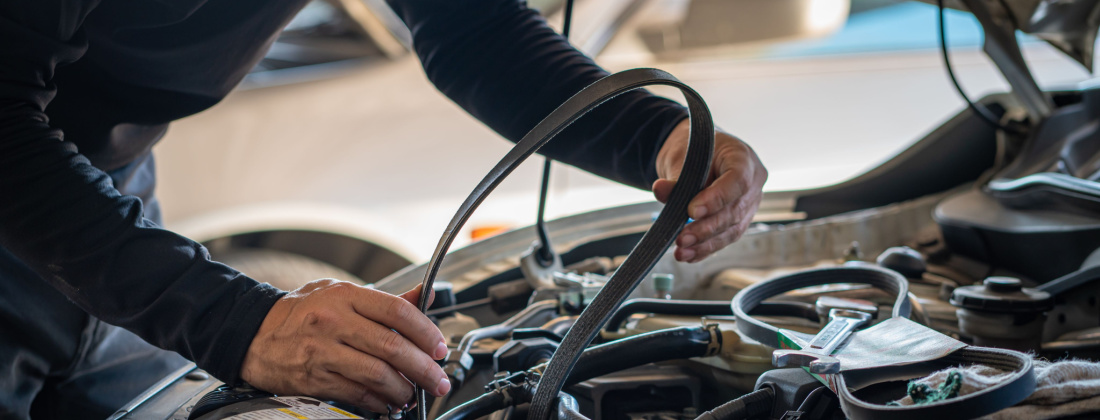
Timing Belt Replacement at Ward Tire
Everything revolves around timing. Jokes, music, food, relationships, and even engines! Because your car’s engine relies on a timing belt to keep everything running smoothly. The timing belt ensures that everything in the engine runs properly, which keeps you safe on the road.
Timing belt replacement is a crucial maintenance component! So, if you own a car, you should know how a timing belt works and when it has to be replaced.
This guide will teach you about the Timing Belt and its core reasons for replacement.
What Is a Timing Belt?
A timing belt is an internal combustion engine component that synchronizes the movement of the crankshaft and camshafts. It has a precise hard tooth that interlocks the crankshaft cogwheel and the two camshafts. The intake and exhaust valves open and close in sync with the pistons due to the precise teeth of a driving belt.
It guarantees that the intake and exhaust valves of the engine open and close in sync with the pistons. The car will not function properly if the crankshaft and camshaft are not acting in sync.
Types of Timing Belts
Timing Belts are divided into the following types-
- Pitch selection
- Pulley selection
- Pulley drawing
- Belt selecting
- Shaft selecting
- Design assembly
Advantages of a Properly Functioning Timing Belt
- Precision registration and timing with no loss of high torque-carrying capability
- Minimal vibration and chordal effect
- Positive slip-proof engagement
- Wide speed range is especially important when the entire speed range is developed from a single source
- Virtually no elongation (stretching) due to wear
- Power transmission efficiency is not lost with the use
- The clean operation, no need for lubrication
- Reduced noise
- Long, dependable, trouble-free service
- Excellent abrasion resistance
- Rust resistant
- Resists chemicals and contaminants
- Increased drive design options
- Weight savings
- Safety issues
Difference Between Timing Belt and Chain
Depending on your car type, you may have a timing chain instead of a timing belt. A timing chain performs the same purpose as a belt, except it is made of metal rather than rubber. Timing belts became popular when they were introduced in the 1960s because they are lighter and quieter.
Due to design advances and a lengthy lifespan, some current automobiles have reverted to employing timing chains. If your automobile utilise a timing chain rather than a timing belt, you may be able to go longer between timing chain replacements.
Core Functions of Timing Belts
The timing Belts play an important role in holding the best performance of your vehicle:
- The Timing belt enables you to achieve the entire combustion process as the control of the piston & valves relies on it.
- It joins the crankshaft and camshaft to regulate the valve action.
- The timing belt guarantees that the engine’s valves open and close precisely.
- Other engine components include a water pump, an injection pump, and an oil pump.
- The timing belt controls the valve with the same combustion mechanical energy. It signifies that no external sources are used.
- Another function of a timing belt or chain is to keep the piston from impacting the valves at an excessively high level.
When to Replace a Timing Belt
Changing your timing belt at the mileage intervals recommended by your vehicle’s manufacturer is critical. Each manufacturer is different but should be replaced every 100,000 to 160,000 Kilometers. The suggested interval for your particular vehicle may be found in the owner’s handbook.
Because the timing belt is made of rubber, it will wear down over time and eventually break. When it breaks, the engine will stop running, or the components will be out of sync, damaging the engine.
The owners manual of your car will tell you when you have to change your timing belt. You have to change it before it becomes a serious problem. A lot of vehicles have complicated internal systems that must work in perfect synchrony all together and when the timing belt breaks, the internal parts of the engine are destroyed and the synchrony is gone. This happens so fast that you might not get a warning.
Warning Signs Its Time for a Replacement
Every vehicle indicates when it has any technical glitches in it. Here are a few of the warning signs-
- Decreased engine power
- Overheating
- Shocking & Vibrating
- Trouble starting the vehicle
- Oil Leakage
- Check engine light
- Ticking noise coming from the engine
Schedule Your Visit to Ward Tire Today!
Repairing or replacing the Timing belt is considered an expensive service and an Intricate, labor-intensive process. If your vehicle experiences such kind of glitches, then come to the workstation of the Ward Tires. We specialise in repairing and maintaining the engine of a vehicle.
At our auto repair shop, our certified technicians have been replacing timing belts for years. Our expert technicians will examine your vehicle, identify any damage to your belt, and replace it with quality service at an affordable price. If you’re looking for a timing belt service Give us a call or schedule an appointment online.

